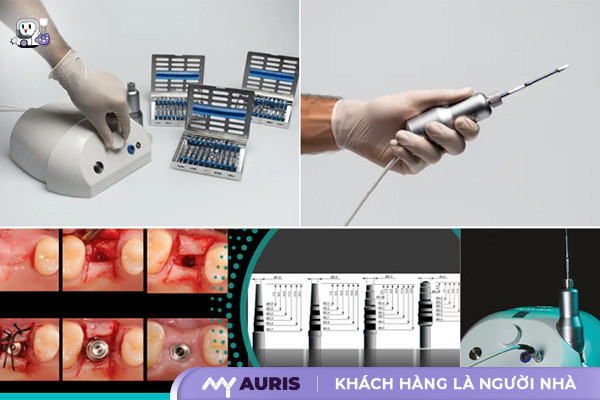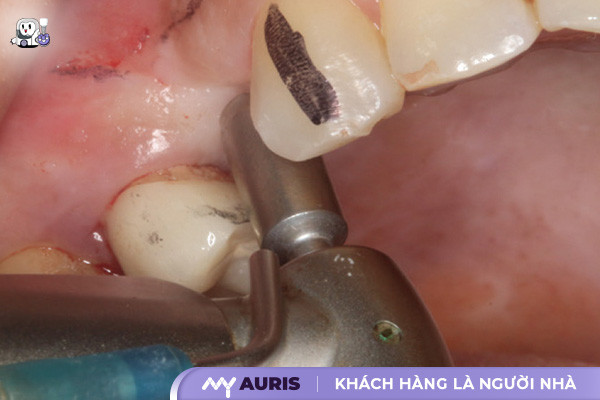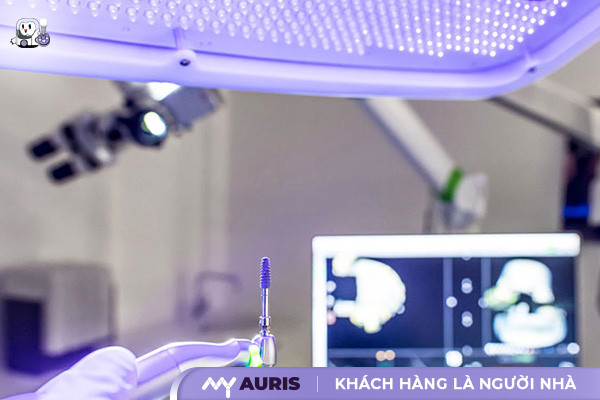Magnetic technology in implant implantation is an advanced method that uses the compression principle of magnetic field and electric current, combined with a high-frequency ultrasonic drill, vibrating in vertical motion. This process creates a vibration mechanism to separate bones. There is no need to drill and cut the bone, but the bone is “moved”, “transformed” and “compressed”, helping to preserve bone and soft tissue to the maximum. Thanks to that, the transplant is performed gently, quickly, painlessly and minimizes healing time compared to traditional techniques. At My Auris Dental Clinic, a team of highly specialized doctors and modern equipment always ensure optimal efficiency and safety for customers.
Magnetic technology in implants
This technology uses the attraction of a magnetic field to fix the implant to the jawbone. The implant is specially designed, integrated with magnets. The doctor places the implant into the jawbone, then uses medical equipment to create a magnetic field to firmly attach the implant. Magnetic force helps stabilize the implant, promoting biological integration between the implant and the jawbone, allowing for quick recovery of chewing function. This technology is non-invasive, less painful than traditional implants, and minimizes recovery time. This type of technology is a great step forward in the application of technology to medicine, specifically dental implants.
Rapid biological integration thanks to magnetic force helps the jawbone and implant connect quickly, shortening recovery time. Restore chewing function sooner, patients can eat and drink comfortably after a short time. Less pain, no need for invasive surgery, minimizes soft tissue damage, providing a comfortable experience for the patient. High aesthetics because the implant integrates perfectly with the jawbone, creating a solid foundation for dentures. The long-term durability of the implant material can withstand high chewing forces. Safe and effective magnetic technology, high success rate. This is a superior dental solution, suitable for many patients with tooth loss.

Implant procedure using magnetic technology
Step 1: Dental examination and treatment planning.
Patients with tooth loss need a dental exam. The doctor checks the health of teeth and jaw bones. Doctors use modern medical equipment such as X-rays and CT scanners to evaluate the condition of the jawbone and implant location. From there, the doctor creates an appropriate treatment plan, chooses the optimal implant size and implant location. This plan ensures high aesthetics and restores good chewing function. Patients are privateDetailed information about the implant method, advantages, disadvantages, implant costs.
Step 2: Implantation.
The doctor performs dental surgery to implant the implant. Magnetic technology supports precise positioning and placement of implants into the jawbone. Magnetic force helps fix the implant and integrate biologically with the jawbone. This implant method is less painful and less invasive than traditional implants. Recovery time is faster, minimizing complications.
Step 3: Install dentures.
After the implant is completely integrated with the jawbone, the doctor proceeds to install the denture. Dentures are designed to match the jaw shape and natural tooth color. The patient has new teeth, restoring chewing function and aesthetics.
Step 4: Monitoring and post-implant care.
Patients need regular dental check-ups. The doctor monitors the implant integration process and checks oral health. Patients are instructed on proper oral care and maintaining the long-term durability of the implant.

The cost of implants using magnetic technology
The cost of implants using magnetic technology depends on many factors. There is no fixed number. Each patient has a different oral and jaw health condition. This affects the dental treatment method, implant type, implant technique and recovery time.
The following factors should be considered to estimate the cost of magnetic implants:
- Jaw bone condition: Strong jaw bone is the foundation for dental implants. If the jaw bone is weak, bone grafting is needed before implant placement. This increases costs and treatment time. The doctor will evaluate the condition of the jaw bone through dental examination and X-rays.
- Number of implants: Single tooth implant is different from multiple tooth implants. The number of implants needed directly affects the cost.
- Implant type: As medical technology develops, the market now has many types of implants with different materials, designs and technologies. Each type of implant has its own price. Implants with good biological integration and high durability often cost cao more. Patients need to carefully learn about the advantages and disadvantages of each type of implant to choose appropriately.
- Doctor’s skills: Doctors with high experience and professional skills ensure the success rate of the transplant. Costs for good doctors are often higher. However, this is a worthy investment for oral health and aesthetics.
- Medical equipment: Medical equipment meets quality standards, modern technology supports the implant process accurately, safely and with less pain. Using modern equipment often comes at a higher cost than manual equipment or outdated applications.
- Geographical location: Implant costs may vary depending on the geographical location of the dental clinic.
Compare traditional implant technology and magnetic technology
Advantages advantages and disadvantages of each method
| Characteristics | Traditional Implants | Magnetic Implants |
|---|---|---|
| Methods | Using manual equipment to place implants | Applying magnetic force for integration implant |
| Invasiveness | Invasive | Non-invasive |
| Pain | Pain | Less pain |
| Recovery time Recovery | Long | Fast |
| Biological integration | Good | Very good |
| Success rate | High | Under research and development, potential High |
| Cost | Relatively low | High |
| Technology | Familiar, popular | Latest, advanced |
| Requirements for doctors | Surgical experience surgery | Highly specialized experience, special skills |
| Equipment requirements | Standard surgical equipment | High quality, specialized medical equipment |

Suitable applications for each method
| Criteria | Traditional Implant | Magnetic Technology |
|---|---|---|
| Suitable subjects | Most patients lose teeth, The jaw bone is strong enough | Patients want fast, painless, highly aesthetic recovery; eFear of surgery |
| Application properties | Temporary solution, outdated but still effective | Future-oriented, advanced |
| Advantages | Reasonable cost (depending on the case) | Fast, painless, aesthetic rehabilitation high |
| Disadvantages | Long recovery time, surgery required | Need a doctor with experience and specialized skills, costs may be higher (not clearly mentioned) |
| Factors to consider | Cost, recovery time | Look for a specialist High technology, new technology so need to learn thoroughly |
| Overview | Popular method, effective for many cases but needs recovery time | Modern method, optimal in terms of time and aesthetics but need to learn carefully about the doctor and technology |
The future of magnetic implant technology
Potential improvements
Research on magnetic technology in implants is constantly evolving. Medical equipment and dental solutions based on magnetic forces are being perfected. Application of new technology helps better biological integration, less pain, faster recovery time.
Here are some potential improvements:
- Implant materials: Research focuses on highly biocompatible materials, quick jawbone integration, and long-term durability. Implant manufacturing techniques are more precise, minimizing size, increasing aesthetics.
- Magnetic devices: Devices that create magnetic fields and magnetic forces are compactly designed and easy to use. Applying new technology to control magnetic force accurately, increasing success rate and reducing complications.
- Implantation technique: Develop a non-invasive, painless implantation technique with fast recovery time. Mechanical technology and new technology applications support doctors in performing accurate and safe implants.
- Technology integration: Combining magnetic technology with other technologies such as 3D printing technology and artificial intelligence. Advanced dental solutions help personalize treatment and optimize implant results.
These improvements make magnetic technology safer, more effective, and less painful. Patients suitable for this implant method will enjoy outstanding benefits. Doctors with experience and highly specialized skills will perform the transplant successfully.

Future applications
Magnetic implant technology opens up many potential future applications of dentistry:
- Comprehensive oral restoration: Magnetic implants help restore lost teeth, improve chewing function and aesthetics. This method is suitable for many cases of tooth loss, including complete tooth loss.
- Treatment of dental diseases Mouth: This technology supports the treatment of jaw bone diseases and bone loss. Applied in rehabilitation and jaw bone regeneration.
- Implants for special patients: Patients with systemic diseases, who are difficult to perform traditional implants, can use this method of minimal invasiveness, minimizing risks risk for patients.
- Aesthetic dentistry: Applying magnetic technology to create highly aesthetic, biocompatible dentures that meet the beauty needs of patients.
- Reduce costs and treatment time: Improved techniques and medical equipment help reduce costs and treatment time. Implants are painless and have quick recovery time, saving time and money for patients.
The future of dentistry is closely linked to the latest medical technology Magnetic implants are an important step forward, bringing great benefits to patients and doctors. High-quality medical equipment and reasonable implant costs will help this method become widely popular, providing an effective and safe dental solution, contributing to improving oral health for the community.





